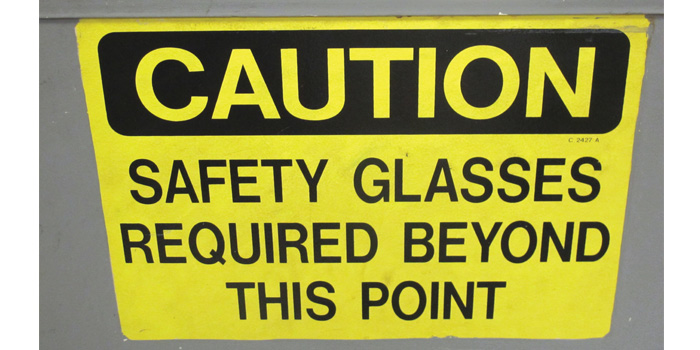 In your personal life, there are all sorts of protective products and equipment available to help keep you safe: seat belts, helmets, car seats for the kids…even sunscreen to help protect your skin from the sun’s dangerous rays.
In your personal life, there are all sorts of protective products and equipment available to help keep you safe: seat belts, helmets, car seats for the kids…even sunscreen to help protect your skin from the sun’s dangerous rays.
Though some of this protective gear is regulated by law, the decision to use it is still up to you. For example, most states have motorcycle helmet laws, but they aren’t required for all riders, leaving riders with the choice of whether to protect themselves or take their chances without a helmet. Similarly, seat belt laws vary from state to state, often based on your age and where you’re sitting. In many states, you can even be pulled over and ticketed just for not wearing a seat belt. This means it’s up to you to decide whether it’s worth the risk.
Employee’s Discretion
Often, the same feeling occurs in the workplace. There’s a wide variety of protective equipment available for employees in auto repair, from gloves and hard hats to footwear and hearing protection. But at the end of the day, much of it is at an employee’s discretion. Sure, you’re responsible for wearing it, but do you remove it when someone isn’t looking? The fact of the matter is that you’re the one who will face the painful results if there’s an accident.
Before you make the decision not to don that piece of protective equipment, let’s consider your risks and your role regarding PPE in the workplace.
Workplace Injury Facts
According to estimates from the Survey of Occupational Injuries and Illnesses (SOII) conducted by the U.S. Bureau of Labor Statistics, more than 3 million nonfatal workplace injuries and illnesses were reported by private industry employers in 2013 (survey results were released last December). This results in an incidence rate of 3.3 cases per 100 equivalent full-time workers. In that same year, 4,585 workers died on the job. Although fewer people are getting sick and injured at work than in the past, the statistics clearly show that there is more work to do.
Without extensive use of personal protective equipment (PPE), imagine how much higher these numbers would be. Nearly 20 years ago, the Occupational Safety and Health Administration (OSHA) acknowledged the link between injury prevention and PPE. Thus, the Personal Protective Equipment Standard (29 CFR 1910, Subpart I) was enacted to enforce a more proactive role in safety.
The PPE Standard
OSHA wants employers to be responsible for the majority of PPE requirements, but everyone shares responsibility for safety. Let’s break it down:
Employers. Employers are responsible for determining how they can reduce injury risk for their employees. This involves evaluating:
- Engineering controls, including incorporation of physical changes to the work environment or adjusting a piece of equipment to make it safer to use.
- Work practice changes, including initial and ongoing training for employees on how to perform their jobs in safer ways.
- Administrative changes that control how and when workers do their jobs. This could include changing schedules or rotating workers to different tasks to reduce risk exposure. Employers are responsible for conducting a hazard assessment, which requires a walk-through of a facility to identify physical and health hazards. Common physical hazards include moving objects, fluctuating temperatures, high-intensity lighting, rolling or pinching objects, faulty electrical connections and sharp edges. Common health hazards include the presence of harmful dusts, flammables, chemicals or radiation. Next, employers are responsible for choosing the correct PPE. To assess what each employee needs to stay safe on the job, employers should:
- Determine what hazards remain (after the hazard assessment).
- Identify what PPE is necessary to protect employees from those hazards.
- Communicate and train employees on the proper use of PPE.
- Instruct employees on the maintenance of their PPE.
- Review the PPE program and make any necessary changes.
- Employers are responsible for training workers on the proper use of PPE before the individual enters the work area. They’re also required to retrain workers when equipment or circumstances change, or when it’s evident that a worker is not clear about the proper use of PPE.
- Employers are responsible for ensuring that employees are using PPE properly on the job. An easy way to do this is by simply setting a good example, establishing a “no exceptions” policy, counseling and disciplining employees who violate safety policies, and buying equipment that exceeds standards.
- Finally, employers are responsible for periodic assessments of a facility’s PPE policies, as well as injury and illness records. This annual review reminds safety managers and other supervisors to spot any trends or areas of concern regarding safety, and to take the appropriate actions necessary to prevent accidents in the future.
Employees. Though most requirements regarding PPE fall on the employer, the decision to stay safe in the work area is still up to the workers themselves. According to the OSHA standard, workers are responsible for:
- Wearing PPE properly
- Attending training sessions on PPE
- Caring for, cleaning and maintaining their PPE
- Informing their supervisor of the need to repair or replace PPE
Two-Way Street
Of course, OSHA standards may vary depending on your particular workplace or state, so speak to your supervisor or company’s safety manager for any PPE-related questions or needs. PPE and safety are both two-way streets, and will ultimately be the most successful when everyone is invested in the cause.
In the next Health and Safety column in the November issue of BodyShop Business, we will talk about specific types of PPE essential to your business.













